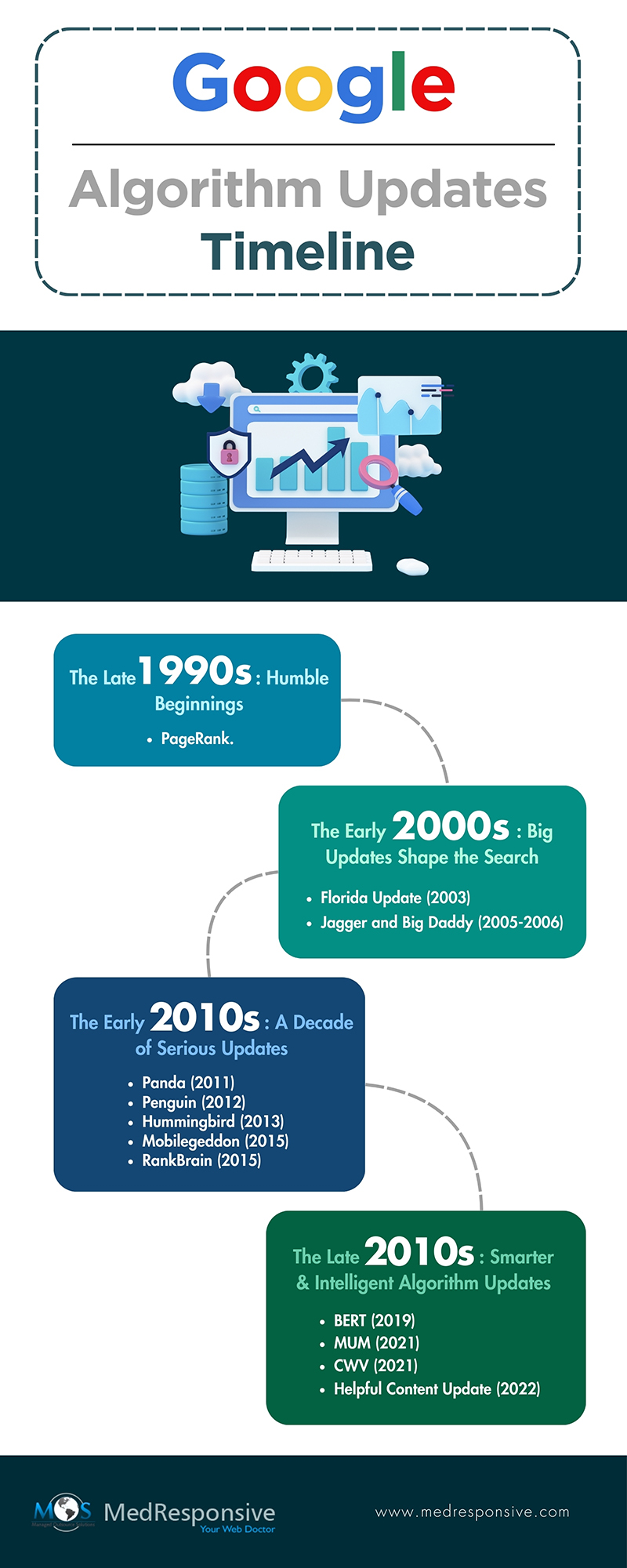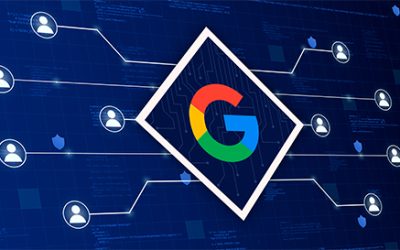It may not be surprising these days how Google seems to know exactly what we are thinking about when it presents search results; regardless of whether we are looking for a nearby cafe or a complex scientific formula. It all comes down to the magic of the search engine giant’s revolutionary algorithm.
But, as you may know, Rome wasn’t built in a day.
Yes. This magic wasn’t conjured up in a day (or night). In fact, it took Google over two decades to figure out how to display and rank results—exactly in the way we wanted.
Let us now take a journey through time to figure out the history of Google algorithm and how it developed and transformed into the most sophisticated search engine that we all rely upon on a daily basis.
The Late 1990s: Humble Beginnings
In 1996, Larry Page and Sergey Brin—two Stanford PhD students, developed a search engine called, “Backrub.”
Yup, Backrub.
They named the program that, because it analyzed the web’s “back links” to understand how important a website was, and what other sites it was related to. The name stuck on for a year, before a graduate student Sean Anderson suggested the term, “googolplex” and Page shortened it to Googol. They then accidentally searched for the term, “Google.com” whilst looking for a domain name to register, which eventually Page liked and they registered it in the Fall of ‘97.
Anyhow, that’s the history regarding how the name came into place.
Regarding the first major breakthrough, it was around a year later when Google’s core algorithm was built on a simple, but revolutionary idea: PageRank.
PageRank algorithm analyzed the number and quality of links that were pointed to a page, which was used to determine its significance. The logic was simple—if other websites were linking to a page, it must be valuable.
This was revolutionary, compared to other search engines of the time, which ranked results based on the number of keywords on the page. Google delivered relevant results almost all the time. However, it was far from perfect. Foxy webmasters exploited the system through keyword stuffing and link farms, which called for an urgent revamp of the present algorithm.
The Early 2000s: Big Updates Shape the Search
With the start of the millennium, post the dot-com boom and crash, the digital landscape was going through a violent shakeup, and so was Google. While many dot-com startups and peers faced shut down, Google in an attempt to stay afloat, refined its algorithm through a series of updates which would later not just redefine the future of the company, but the Web itself.
- Florida Update (2003)
This first update was Google’s big attempt to squash spamming. All of a sudden, websites that stuffed keywords in their pages and relied on hidden text were penalized. Many business owners faced the heat, but it opened up the way for websites that presented cleaner and more user-friendly content.
- Jagger and Big Daddy (2005-2006)
These updates targeted websites with low-quality backlinks, thereby prioritizing link quality rather than quantity. Those websites that had either purchased links or had deployed some unethical practices saw their rankings stoop, signaling a clear message: integrity mattered in search.
The Early 2010s: A Decade of Serious Updates
With the internet exploding into the mainstream channels, tons of content filling the Web each day, search behaviors started to evolve which also meant Google had to get smarter with its algorithm. This decade saw the most significant updates in SEO history, reshaping how enterprises approached search engine optimization.
- Panda (2011)
The Panda update was the start of a turning point. It identified and lowered the rankings of low-quality, less content and rewarded high-quality, useful content. Basically, if your website was a treasure trove of valuable content, it would be promoted up the ranks. But if your content was poorly written, Panda was not your friend.
- Penguin (2012)
Google, tired of spammy backlinks, introduced the Penguin update. This update hammered on manipulative link-building practices (which was a norm back then) and rewarded websites that followed organic link-building practices. It basically forced SEOs to focus on earning links naturally rather than staking the system.
- Hummingbird (2013)
Google introduced semantic search through the Hummingbird update, focusing on user intent rather than on a bunch of relevant keywords. This integration enabled the algorithm to better understand what the user would be thinking, allowing it to process complex queries and display results more effectively.
- Mobilegeddon (2015)
With the widespread adoption of smartphones in the early 2010s, mobile browsing became the norm, which made Google include mobile-friendliness as a ranking factor. Those websites that weren’t optimized for mobile devices were put down the ladder, ensuring users always had a better browsing experience.
- RankBrain (2015)
This update was the game changing moment with Google, as it took its first real steps into Artificial Intelligence. RankBrain, an AI-powered system, enabled Google to process search queries more effectively, as it was trained to understand nuanced language and hence deliver more accurate results, especially for ambiguous or long-tail searches.
The Late 2010s: Smarter & Intelligent Algorithm Updates
Artificial Intelligence has revolutionized Google’s algorithm updates like never before. The series of Google AI search updates have transformed search results from responding to what you type to predicting what you’d need.
- BERT (2019)
Bidirectional Encoder Representations from Transformers (BERT), could be termed as the more polished version of RankBrain, brought on for understanding natural language. It enabled the search engine to understand the context of complex queries—context, subtle nuances and prepositions. For example, when a user types, “European traveler needs a US visa”, BERT understands that an European traveler is planning to travel to the US and is looking for how and where to apply for a visa.
- MUM (2021)
MUM (Multitask Unified Model) was an update that took things a further notch ahead, enabling Google to process and interpret information across multiple languages in video, audio and image simultaneously. It’s designed to answer complex queries that require nuanced understanding and provides more relevant and accurate information.
- CWV (2021)
Core Web Vitals (CWV) was an update that solely focused on improving user experience through metrics like a website’s loading speed, visual stability and interactivity. Websites that met these criteria were rewarded with higher rankings, demonstrating Google’s effort in prioritizing user experience and satisfaction.
- Helpful Content Update (2022)
Google’s Helpful Content Update is sending out a clear message: content created with the sole purpose of increasing rankings, is not going to cut it. The search engine instead will be valuing websites that provide genuine and informative content to its users, thereby aligning with their mission of making valuable information universally accessible.
What Does the Future Hold for Google’s Algorithm?
With technology advancing at breakneck speed, Google’s algorithm will only keep getting better and better. Here are a few possible things that may occur in the near future:
- Growth of AI: If you are wondering how much more Google’s search algorithm can grow, expect AI tools like Bard and advancements in natural language processing to further enhance precision in search.
- Visual Search: With social media platforms like TikTok, Instagram and Pinterest gaining popularity each day, visual search will fast become a key focus area. Google Lens is just the tip of the iceberg.
- E-E-A-T: Expertise, Experience, Authority, and Trustworthiness (E-E-A-T) will grow in relevance when it comes to content ranking, especially for industries like finance and healthcare.
Key Takeaways
Content is King, has always been the King and will stay the King.
The key takeaway from all the above-mentioned updates is that the focus has always been on the quality of content and improving user experience. Therefore, focus on creating user-friendly content, a website to match for, and you will keep rising in the rankings.
Resorting to black hat SEO tactics may give short-term gains, but in the long run, those tactics will hurt. Stick to clean practices and keep an eye on Google’s core updates, audit and optimize your website accordingly to maintain visibility.
Most importantly, consider collaborating with an expert provider of SEO consulting services like MedResponsive, if you are feeling overwhelmed by Google’s algorithm updates and the tech associated with it. MedResponsive has the skill sets and a team that can work to fix your website’s underlying issues and propel your website to the summit.
Final Thoughts
The Google algorithm evolution is a testament to not only their commitment to delivering the best results, but also how much technology has come forward in those years. The future looks promising and by understanding the evolution, you can get a sense of how to optimize your website to ensure that it stays ahead of the curve, in the ever-evolving world of search. Let’s join hands and embrace the future of SEO!





